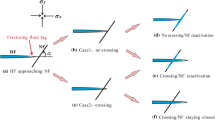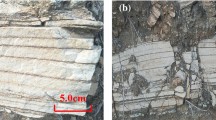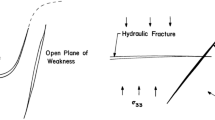Abstract
In this study, the displacement discontinuity formulation is used to solve the problem of interaction between hydraulic fractures (HF) and natural fractures (NF). Furthermore, a numerical program (2DFPM) is developed to study the mechanical activation of a NF because of the propagation of the HF. The accuracy of the numerical method is enhanced using the higher-order displacement variation along the HF and the special crack tip element near its ends. The maximum tangential stress criterion is implemented to predict the HF propagation path, and the stages of hydraulic fracturing tip approaching, coalescence and fluid penetration along the NF are modeled. The tangential stress around the NF with different contact modes (bonded, sliding and opening) is calculated by coupling the finite difference and boundary element methods. The location of secondary tensile fracture that re-initiates along the opposite side of NF is determined, and the key parameters that have great influence on interaction process are discussed. The results show that position, distance and inclination of the HF relative to the pre-existing discontinuity have a strong influence on the HF propagation path.




















Similar content being viewed by others
References
Aliabadi MH (2002) The boundary element method, vol 2. Wiley, England
Aliabadi MH, Rooke DP (1991) Numerical fracture mechanics. Computational Mechanics Publications, Southampton
Beugelsdijk LJL, De Pater CJ, Sato K (2000) Experimental hydraulic fracture propagation in multi-fractured medium. In: SPE 59419, Presented at the SPE Asia Pacific conference on integrated modeling for asset management, Yokohoma, Japan, 25–26 April 2000
Blanton TL (1982) An experimental study of interaction between hydraulically induced and pre-existing fractures. In: SPE 10847, Presented at the SPE unconventional gas recovery symposium, Pittsburgh, Pennsylvania, pp 16–18
Brooks Z, Ulm F, Einstein H (2013) Environmental scanning electron microscopy (ESEM) and nanoindentation investigation of the crack tip process zone in marble. Acta Geotech 8:223–245
Chuprakov DA et al (2010) Hydraulic fracture propagation in a naturally fractured reservoir, SPE 128715
Cooke M, Underwood C (2001) Fracture termination and step-over at bedding interfaces due to frictional slip and interface opening. J Struct Geol 23:223–238
Crouch SL, Starfield AM (1990) Boundary element methods in solid mechanics: with applications in rock mechanics and geological engineering. Allen and Unwin, London
Daneshy AA (2003) Off-balance growth: a new concept in hydraulic fracturing. J Pet Technol, April 2003, pp 78–85
Daneshy AA (2004) Analysis of off-balance fracture extension and fall-off pressures. In: SPE 86471, Presented at the SPE international symposium and exhibition on formation damage control, February. 18–20, 2004. Lafayette
Daneshy AA (2005) Impact of off-balance fracturing on borehole stability and casing failure. In: SPE 93620, Presented at the SPE western regional meeting, March 30–April 1, 2005. Irvine, CA
Erdogan F, Sih GC (1963) On the crack extension in plates under plane loading and transverse shear. J Basic Eng 85:519–527
Hossaini Nasab H, Marji MF (2007) A semi-infinite higher-order displacement discontinuity method and its application to the quasistatic analysis of radial cracks produced by blasting. J Mech Mater Struct 2(3):439–458
Li Li et al (2013) A numerical investigation of the hydraulic fracturing behaviour of conglomerate in Glutenite formation. Acta Geotech 8:597–618
Marji MF, Dehghani I (2010) Kinked crack analysis by a hybridized boundary element/boundary collocation method. Int J Solids Struct 47:922–933
Marji MF, Hosseini-Nasab H, Kohsary AH (2006) On the uses of special crack tip elements in numerical rock fracture mechanics. Int J Solids Struct 43:1669–1692
Scavia C (1995) A method for the study of crack propagation in rock structures. Géotechnique 45(3):447–463
Shou KJ, Crouch SL (1995) A higher order displacement discontinuity method for analysis of crack problems. Int J Rock Mech Min Sci Geomech Abstr 32:49–55
Tada H, Paris PC, Irwin GR (1985) The stress analysis of cracks handbook. Del Research Corporation, St. Louis
Thirecelin M, Makkhyu E (2007) Stress field in the vicinity of a natural fault activated by the propagation of an induced hydraulic fracture. In: Proceedings of first Canada-US rock mechanics symposium—rock mechanics meeting society’s challenges and demands, vol 2, pp 1617–1624
Warpinski NR, Teufel LW (1987) Influence of geologic discontinuities on hydraulic fracture propagation. J Pet Technol 39(2):209–220
Warpinski NR, Teufel LW (1991) Hydraulic fracturing in tight, fissured media. J Pet Technol 4(2):146–209
Whittaker BN, Singh RN, Sun G (1992) Rock fracture mechanics, principles, design and applications. Elsevier, Netherlands
Xue W (2010) Numerical investigation of interaction between hydraulic fractures and natural fractures, Master of Science Thesis, Texas A&M University, December 2010
Zhang X et al (2006) The role of friction and secondary flaws on deflection and re-initiation of hydraulic fractures at orthogonal pre-existing fractures. Geophys J Int 166:1454–1465
Zhou J et al (2008) Analysis of fracture propagation behavior and fracture geometry using a tri-axial fracturing system in naturally fractured reservoirs. Int J Rock Mech Min Sci 45:1143–1152
Zhuang XY, Augarde C, Bordas S (2011) Accurate fracture modelling using meshless methods and level sets: formulation and 2D modelling. Int J Numer Methods Eng 86:249–268
Zhuang XY, Augarde C, Mathisen K (2012) Fracture modelling using meshless methods and level sets in 3D: framework and modelling. Int J Numer Methods Eng 92:969–998
Author information
Authors and Affiliations
Corresponding author
Appendix
Appendix
The tangential stresses σ i+ t and σ i− t on the both side of the ith element of the crack can be written in the following form:
where
where β is the inclination angle of the elements and
In which, the term \( \frac{1}{2}({\mathop {\sigma_{t} }\limits^{i}}^{ - } + {\mathop {\sigma_{t} }\limits^{i}}^{ + } ) \) is continues. This term represents the combined effects of the N elemental displacement discontinuities along the boundary and is written [8]:
then
The maximum principal stress is calculated along the frictional interface at points between successive elements from the normal, shear and tangential stresses. The maximum principal stress is determined above and below the interfaces from the respective normal and shear stresses.
When the maximum tensile stress (σ 1) exceeds the tensile strength of the rock, a new fracture will grow perpendicular to the direction of maximum tension. The new splay crack is oriented at an angle α from the frictional interface that is π/2 from the orientation of the maximum tensile stress.
Rights and permissions
About this article
Cite this article
Behnia, M., Goshtasbi, K., Marji, M.F. et al. Numerical simulation of interaction between hydraulic and natural fractures in discontinuous media. Acta Geotech. 10, 533–546 (2015). https://doi.org/10.1007/s11440-014-0332-1
Received:
Accepted:
Published:
Issue Date:
DOI: https://doi.org/10.1007/s11440-014-0332-1




